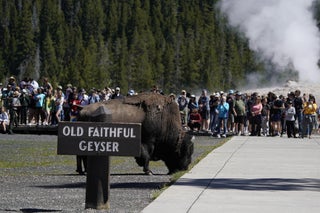

This article originally appeared in Zócalo Public Square. If you know where to go in Death Valley National Park, Wrangell-St. Elias Park and Preserve, Glacier Peak Wilderness, or Bears Ears National Monument, you might come across the remnants of a tramway or a pile of mine tailings or a rusted tank. The artifacts of industrial activity can be startling in the otherwise tranquil natural scene. But there is no mistake. Despite being miles inside a national park, a designated wilderness, or some other conservation area, you can encounter mining claims—they are everywhere. With resource development on public lands once again a matter of national debate, it has become increasingly important to look back and ask: How did protected places and mining get so entangled?
AdvertisementOne hundred and fifty years ago, Congress established two foundational precedents for our national landscape a mere 10 weeks apart: the Yellowstone National Park Act, setting in motion “America’s best idea,” and the General Mining Act, which opened public lands to mining exploration. Between March and May, it seems, President Ulysses S. Grant swung from one apex of the pendulum to the other, making it impossible to settle and privatize the public land in Yellowstone while making it easy to extract valuable minerals from almost anywhere they were found without paying a cent. While these decisions seem diametrically opposed, they have shared priorities that ushered in a new land regime in the U.S., based on a fundamental notion of American land defined by a history of Native expropriation, economic liberalism, and segregated land uses.
On March 1, 1872, Grant signed the Yellowstone National Park Act. It “set apart as a public park or pleasuring-ground for the benefit and enjoyment of the people” some two million acres in the northwestern corner of Wyoming, leaning just a bit into Idaho and Montana. In this remarkable landscape of geysers and bison and bright sulfuric pools, no one was permitted to settle or occupy the land. The resources—timber, minerals, and the like—were to be kept “from injury or spoliation” and all natural spectacles would be retained in “their natural condition.” No “wanton destruction” of game or fish “for the purposes of merchandise or profit” would be permitted.
AdvertisementBut on May 10, Grant enacted a bill that has facilitated wanton destruction across many of the country’s public lands and created massive wealth for a few. The General Mining Act of 1872 declared all the U.S. public domain where valuable minerals might be found to be “free and open to exploration and purchase.” This legislation legitimized mining on all surveyed or unsurveyed lands for personal or corporate gain. (The mining that preceded it, such as the California Gold Rush of ’49er fame, was simply overlooked trespassing.) The law remains in effect, an emblem to the exploitation of natural wealth for profit as the highest possible good assigned to the natural world.